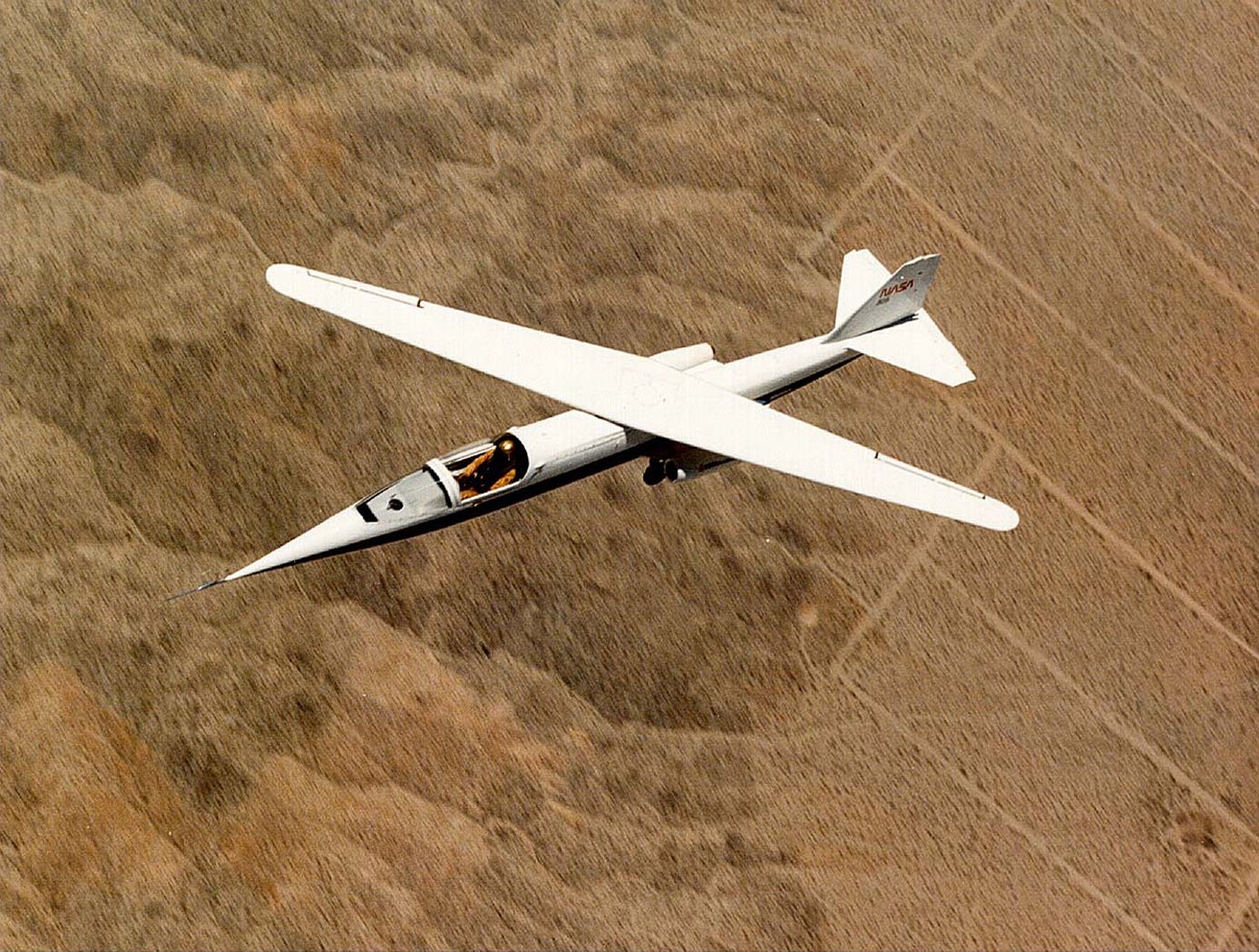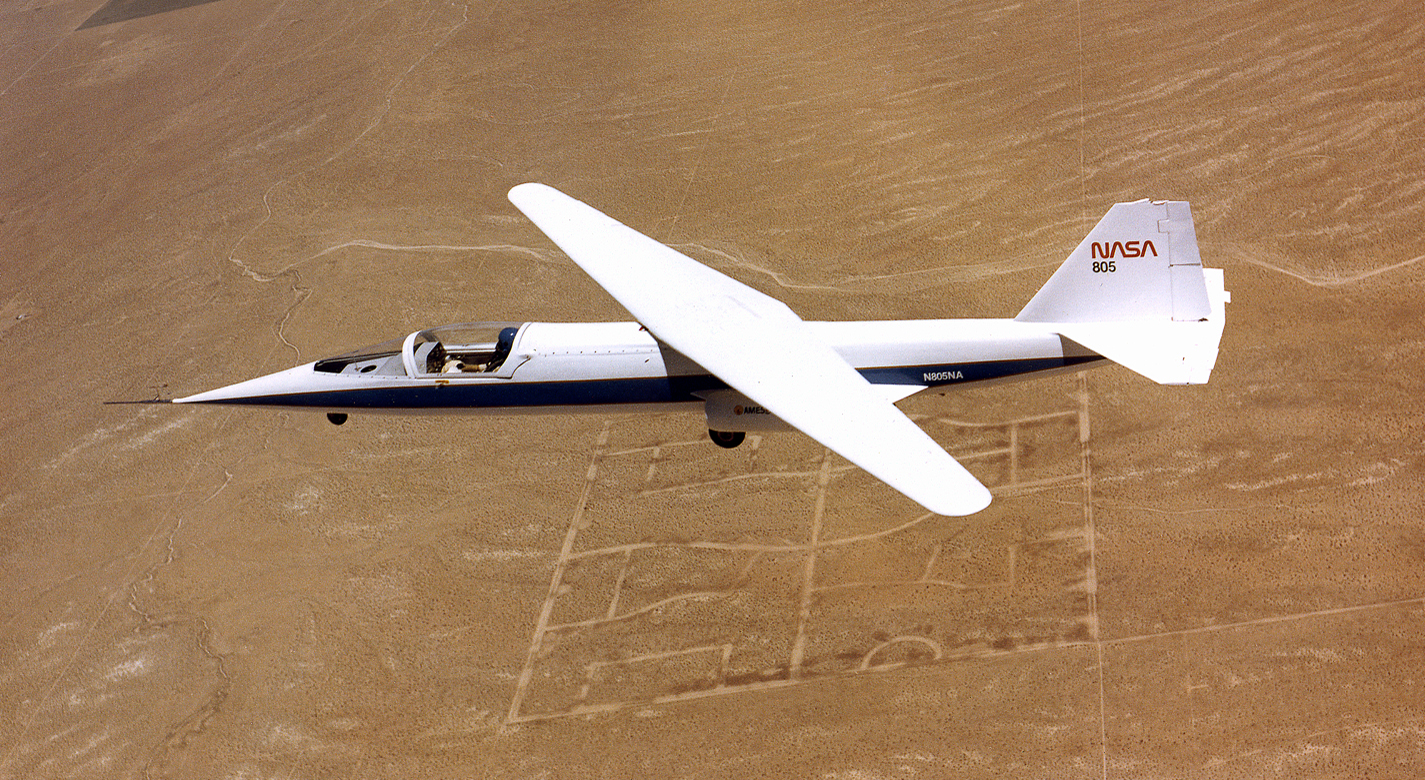Variable Geometry Aircraft Wing Supported By Struts and/or Trusses
aerospace
Variable Geometry Aircraft Wing Supported By Struts and/or Trusses (TOP2-166)
Fuel-Efficient, Airport-Friendly, Multi-Speed Transport Aircraft Configuration with Novel Structural Approach
Overview
NASA has patented a new technology for an aircraft configuration that utilizes a strut/truss-braced oblique variable-sweep wing mounted on a constant cross-section geometry fuselage. In practice, the wing would start in a position closely aligned with the fuselage. This allows the aircraft to easily maneuver within the terminal/ramp area, and promotes higher density terminal operations. During the runup/checkout before takeoff, the wing would be rotated to the unswept position for increased climb performance. Once airborne, the wing would be pivoted to the sweep angle that provides the best aerodynamic performance and noise abatement at the current speed. During cruise, both speed and sweep angles could be adjusted accordingly. Before final approach, the wing would again be rotated to the perpendicular position in order to improve the aircraft's low-speed performance. As the aircraft departs the runway for the taxiway, the wing would be rotated again to align with the fuselage, greatly reducing the possibility of collisions during taxiing.
The Technology
This innovation utilizes a strut/truss-braced oblique variable-sweep wing mounted on a constant cross-section geometry fuselage. The combination of the strut/truss-bracing with the oblique wing greatly reduces the structural and weight penalties previously associated with unbraced oblique wing configurations while maintaining the oblique wings improved aerodynamic performance. Strut/truss bracing helps to further reduce the wing weight, and can be used to automatically align wing-mounted engines with the oncoming flow. The synergistic combination of these design elements provides the aircraft with a wide and efficient cruise speed range when the wing is at intermediate sweep positions, and superior low speed performance when the wing is unswept. The wing could remain aligned during taxiing, reducing the chance of collisions with other taxiing aircraft. This wide speed envelope provides future air traffic systems with additional flexibility when scheduling efficient arrivals and departures. The improved climb performance of the straight wing reduces the neighborhood noise footprint of the aircraft as it departs the airport. Efficient aircraft designs are increasingly desired in order to support the continued growth of the air transportation industry. Continued expansion of this vital mode of transportation is threatened by ever-increasing challenges in emissions, noise, and fuel efficiency.


Benefits
- Reduced noise during takeoff and landing
- Weight penalty can be substantially reduced by using the strut/truss brace
- Simplified lightweight high-lift (flap) systems
- Approach and landing speeds would be greatly reduced
- Improved aerodynamic performance
- Reduces the possibility of collision during taxiing and improving gate access
- Flexibility in cruise speed operations
Applications
- Aerospace Engineering
- Systems Engineering
- Unmanned Aerial Vehicles (UAV)
- Aircraft
- Manufacturing
Similar Results

Aerodynamically Actuated Thrust Vectoring Device
The thrust actuating device includes several innovations in the aerodynamically stable tilt actuation of propellers, propeller pylons, jets, wings, and fuselages, collectively called propulsors. The propulsors rotate between hover and forward flight mode for a tilt-wing or tilt-rotor aircraft. A vehicle designed using this technology can transition from a hovering flight condition to a wing born flight condition with no mechanical actuation and can do so without complex control systems. This results in a reduction in system weight and complexity and produces a robust and naturally stable hovering aircraft with efficient forward flight modes.

Vertical Take Off and Landing (VTOL) Aircraft with Vectored Thrust for Control and Continuously Variable Pitch Attitude in Hover
The aircraft operates by vectoring the thrust of three independent rotors (propellers). In addition, the vehicle can operate with only thrust vectoring and motor speed control to maintain vehicle attitude in hover and forward (wing born) flight. No other means of vehicle attitude control is required (i.e. ailerons, elevators, rudder), however these additional control surfaces could be added if vehicle control is desired in gliding (non-thrust) conditions.

New Wing Design Exponentially Increases Total Aircraft Efficiency
Adverse yaw, present in current aircraft design, is the adverse horizontal movement around a vertical axis of an aircraft; the yaw opposes the direction of a turn. As an aircraft turns, differential drag of the left and right wings while banking contributes to aircraft yaw. Proverse yaw—yawing in the same direction as a turn—would optimize aircraft performance. Initial results from flight experiments at Armstrong demonstrated that this wing design unequivocally established proverse yaw. This wing design further reduces drag due to lift at the same time.
How It Works
The Armstrong team (supported by a large contingent of NASA Aeronautics Academy interns) built upon the 1933 research of the German engineer Ludwig Prandtl to design and validate a scale model of a non-elliptical loaded wing that reduces drag and increases efficiency.
The key to the innovation is reducing the drag of the wing through use of an alternative bell-shaped spanload, as opposed to the conventional elliptical spanload. To achieve the bell spanload, designers used a sharply tapered wing, with 12 percent less wing area than the comparable elliptical spanload wing. The new wing has 22 percent more span and 11 percent less area, resulting in an immediate 12 percent drag reduction.
Furthermore, using twist to achieve the bell spanload produces induced thrust at the wing tips, and this forward thrust increases when lift is increased at the wingtips for roll control. The result is that the aircraft rolls and yaws in the same direction as a turn, eliminating the need for a vertical tail. When combined with a blended-wing body, this approach maximizes aerodynamic performance, minimizes weight, and optimizes flight control.
Why It Is Better
Conventional aircraft make use of elliptical loaded wings to minimize drag. However, achieving aircraft stability and control in conventional elliptical wings produces a strong adverse yaw component in roll control (i.e., the aircraft will yaw the opposite direction with application of roll control). Therefore, a vertical tail or some other method of direct yaw control is required, such as split elevons for use as drag rudders. The use of elliptical wings also results in a suboptimal amount of structure to carry the integrated wing bending moment.
Adopting the bell-shaped spanload change results in an immediate 12 percent drag reduction. In addition, optimization of the overall aircraft configuration is projected to achieve additional significant overall performance increases.

Improved Fixed-Wing Gust Load Alleviation Device
Gust loads may have detrimental impacts on flight including increased structural and aerodynamic loads, structural deformation, and decreased flight dynamic performance. This technology has been demonstrated to improve current gust load alleviation by use of a trailing-edge, free-floating surface control with a mass balance. Immediately upon impact, the inertial response of the mass balance shifts the center of gravity in front of the hinge line to develop an opposing aerodynamic force alleviating the load felt by the wing. This passive gust alleviation control covering 33% of the span of a cantilever wing was tested in NASA Langleys low speed wind tunnel and found to reduce wing response by 30%.
While ongoing experimental work with new laser sensing technologies is predicted to similarly reduce gust load, simplicity of design of the present invention may be advantageous for certification processes. Additionally, this passive technology may provide further gust alleviation upon extending the use of the control to the entire trailing edge of the wing or upon incorporation with current active gust alleviation systems.
Importantly, the technology can be easily incorporated into to the build of nearly all fixed wing aircrafts and pilot control can be maintained through a secondary trim tab. Though challenging to retrofit, passive gust alleviation could enable use of thinner, more efficient wings in new plane design.

ActiVator: A High-Performance Line Climber for Kite-Based Atmospheric Sensing
The ActiVator is a rigid-wing system designed to transport sensor or instrument packages along a kite line using the lift generated by apparent wind. Unlike flexible, sail-like structures, the ActiVator maintains its aerodynamic shape throughout its flight, except for a movable elevator control surface that adjusts the angle of attack to regulate aerodynamic lift. The structural design leverages principles from aircraft wing engineering, incorporating a reinforced spar capable of withstanding lift-induced bending and drag forces, an aerodynamically optimized leading edge, and a thin trailing edge to achieve higher lift coefficients than typical sail-based designs. The ActiVator can be constructed using a variety of materials, including wood with plastic covering, molded foam with reinforcements, or other lightweight composites tailored for both aerodynamic performance and structural integrity.
The control system mirrors conventional aircraft design, using a movable surface for pitch control, thereby adjusting lift to facilitate climbing or descending. Currently, the ActiVator operates via radio-controlled inputs, but it can also be configured for preprogrammed flight sequences, allowing autonomous operation without active user control.
By offering a stable, compact, and lightweight platform, the ActiVator enables high-performance instrument deployment across diverse wind conditions. Potential applications include air-quality monitoring, atmospheric boundary layer research, distributed weather observations, and remote sensing, such as optimizing the field of view and resolution of a fixed-lens camera. The technology is at Technology Readiness Level (TRL) 4 (validated in a laboratory environment) and is available for patent licensing.



